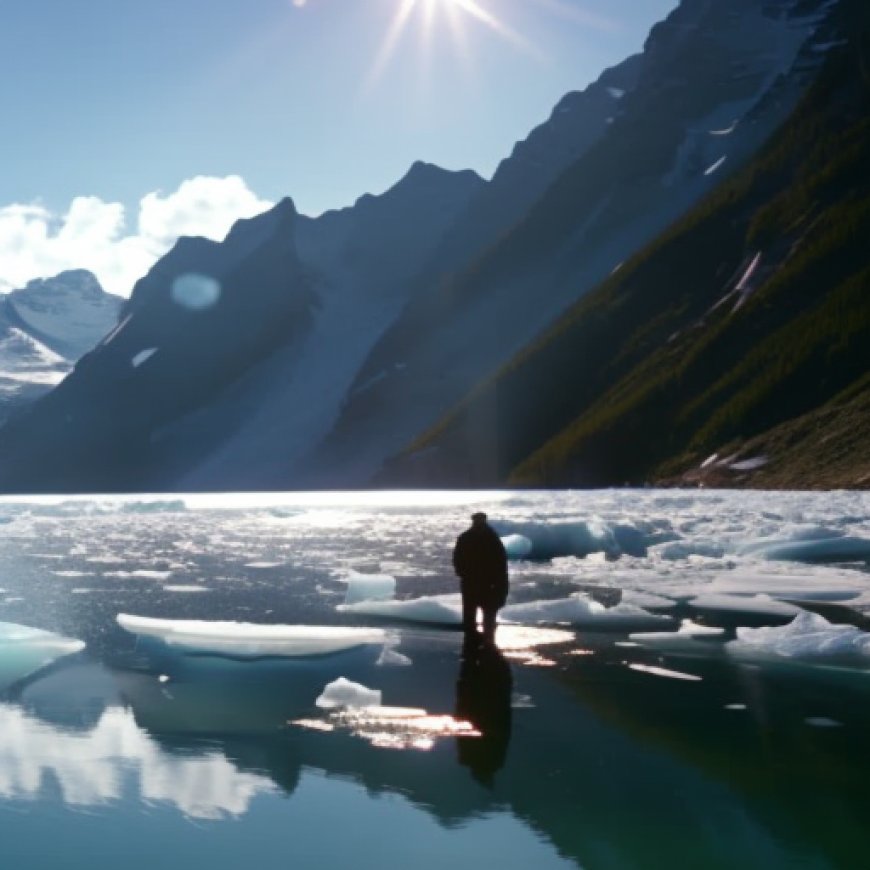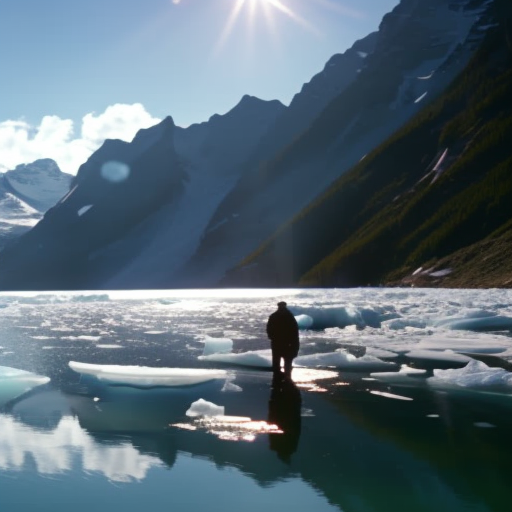What does a melting glacier sound like? ‘Gunshots.’
What does a melting glacier sound like? 'Gunshots.' National Geographic


Tiny Air Bubbles in Glaciers Accelerate Melting, Scientists Discover

A recent discovery by scientists reveals that tiny, pressurized air bubbles trapped in ice are contributing to the accelerated decline of certain glaciers worldwide. This finding has significant implications for the achievement of the Sustainable Development Goals (SDGs), particularly those related to climate action and life below water.
Impact on Tidewater Glaciers
In tidewater glaciers, which are large rivers of ice that flow into the sea, the continuous melting of ice underwater causes billions of these bubbles to burst into the water, resembling “little tiny gunshots,” according to Erin Pettit, a glaciologist at Oregon State University. This release of air disrupts the cold layer of water surrounding the glacial ice, bringing warmer water into contact with it. The bubbles then rise through the water, creating turbulent currents that further expose the ice to warm water.
This phenomenon is particularly concerning for Alaska’s glaciers, where Pettit’s team conducted their study. These glaciers are currently losing over 70 billion tons of ice annually, contributing to rising sea levels globally.
Unlocking the Anatomy of Melting Glaciers
Glaciers contain numerous tiny air bubbles that form as snow accumulates and compresses into ice over thousands of years. A cubic foot of glacial ice can hold over five million bubbles, which are compressed to pressures up to 20 times that of Earth’s atmosphere.
Pettit and her colleagues suspected that these bubbles played a role in accelerating the melting of tidewater glaciers. To test this hypothesis, they conducted laboratory experiments using bubble-rich ice blocks harvested from the Xeitl Sít’ in Tlingit (also known as LeConte Glacier) in Alaska. They observed that the glacial ice melted 2.25 times faster than bubble-free ice, as the rising bubbles pulled water up more quickly and disrupted the insulating layer of cold water.
Discovering the “Snap, Crackle, and Pop” of Glaciers
Pettit first became aware of the importance of bubbles in glaciers while monitoring glacier changes from a safe distance. Hydrophone recordings captured continuous sounds resembling “a sizzling pan of cooking food” at 120 decibels, louder than a car horn or a kitchen blender. These sounds were later identified as air bubbles popping out of the melting ice.
How Bubbles Expose Glaciers to Warming Oceans
The bubbles in tidewater glaciers have the potential to mix up the thin layer of cold water that insulates glacial ice from warmer water. This effect is most pronounced in glaciers that thin substantially as they flow into the ocean, such as those in Alaska, Canada, and Greenland. The highly pressurized bubbles rise explosively in shallow ocean areas, bringing warm water into contact with the ice.
Implications for Rising Seas
While the discovery of the bubble effect does not mean that tidewater glaciers will melt and retreat twice as quickly as previously expected, it does provide insights into the mystery of why some glaciers are melting more rapidly than predicted based on water temperature. This finding will help improve models for predicting future glacier shrinkage as oceans continue to warm.
New Theories about Bubbles in Icy Ecosystems
Pettit speculates that the presence of bubbles in glacial ice may have additional, unseen effects on aquatic ecosystems. For example, the noise generated by the bursting bubbles could provide a hiding place for harbor seals, protecting them from detection by orcas. This hypothesis may explain the decline in seal populations in areas where tidewater glaciers have retreated.
The discovery of the role played by these tiny bubbles in glacier melting and their potential impact on global ocean circulation and sea levels highlights the need for further research and understanding of these processes to address the challenges posed by climate change.
SDGs, Targets, and Indicators
| SDGs | Targets | Indicators |
|---|---|---|
| SDG 13: Climate Action | Target 13.1: Strengthen resilience and adaptive capacity to climate-related hazards and natural disasters | No specific indicators mentioned in the article |
| Target 13.2: Integrate climate change measures into national policies, strategies, and planning | No specific indicators mentioned in the article | |
| Target 13.3: Improve education, awareness-raising, and human and institutional capacity on climate change mitigation, adaptation, impact reduction, and early warning | No specific indicators mentioned in the article | |
| Target 13.b: Promote mechanisms for raising capacity for effective climate change-related planning and management in least developed countries and small island developing States, including focusing on women, youth, and local and marginalized communities | No specific indicators mentioned in the article | |
| SDG 14: Life Below Water | Target 14.3: Minimize and address the impacts of ocean acidification, including through enhanced scientific cooperation at all levels | No specific indicators mentioned in the article |
| Target 14.5: By 2020, conserve at least 10 percent of coastal and marine areas, consistent with national and international law and based on the best available scientific information | No specific indicators mentioned in the article | |
| Target 14.a: Increase scientific knowledge, develop research capacity, and transfer marine technology, taking into account the Intergovernmental Oceanographic Commission Criteria and Guidelines on the Transfer of Marine Technology, in order to improve ocean health and to enhance the contribution of marine biodiversity to the development of developing countries, in particular small island developing States and least developed countries | No specific indicators mentioned in the article |
1. Which SDGs are addressed or connected to the issues highlighted in the article?
- SDG 13: Climate Action
- SDG 14: Life Below Water
2. What specific targets under those SDGs can be identified based on the article’s content?
- Target 13.1: Strengthen resilience and adaptive capacity to climate-related hazards and natural disasters
- Target 13.2: Integrate climate change measures into national policies, strategies, and planning
- Target 13.3: Improve education, awareness-raising, and human and institutional capacity on climate change mitigation, adaptation, impact reduction, and early warning
- Target 13.b: Promote mechanisms for raising capacity for effective climate change-related planning and management in least developed countries and small island developing States, including focusing on women, youth, and local and marginalized communities
- Target 14.3: Minimize and address the impacts of ocean acidification, including through enhanced scientific cooperation at all levels
- Target 14.5: By 2020, conserve at least 10 percent of coastal and marine areas, consistent with national and international law and based on the best available scientific information
- Target 14.a: Increase scientific knowledge, develop research capacity, and transfer marine technology, taking into account the Intergovernmental Oceanographic Commission Criteria and Guidelines on the Transfer of Marine Technology, in order to improve ocean health and to enhance the contribution of marine biodiversity to the development of developing countries, in particular small island developing States and least developed countries
3. Are there any indicators mentioned or implied in the article that can be used to measure progress towards the identified targets?
No specific indicators are mentioned or implied in the article that can be used to measure progress towards the identified targets.
4. Table: SDGs, Targets, and Indicators
| SDGs | Targets | Indicators |
|---|---|---|
| SDG 13: Climate Action | Target 13.1: Strengthen resilience and adaptive capacity to climate-related hazards and natural disasters | No specific indicators mentioned in the article |
| Target 13.2: Integrate climate change measures into national policies, strategies, and planning | No specific indicators mentioned in the article | |
| Target 13.3: Improve education, awareness-raising, and human and institutional capacity on climate change mitigation, adaptation, impact reduction, and early warning | No specific indicators mentioned in the article | |
| Target 13.b: Promote mechanisms for raising capacity for effective climate change-related planning and management in least developed countries and small island developing States, including focusing on women, youth, and local and marginalized communities | No specific indicators mentioned in the article | |
| SDG 14: Life Below Water | Target 14.3: Minimize and address the impacts of ocean acidification, including through enhanced scientific cooperation at all levels | No specific indicators mentioned in the article |
| Target 14.5: By 2020, conserve at least 10 percent of coastal and marine areas, consistent with national and international law and based on the best available scientific information | No specific indicators mentioned in the article | |
| Target 14.a: Increase scientific knowledge, develop research capacity, and transfer marine technology, taking into account the Intergovernmental Oceanographic Commission Criteria and Guidelines on the Transfer of Marine Technology, in order to improve ocean health and to enhance the contribution of marine biodiversity to the development of
Behold! This splendid article springs forth from the wellspring of knowledge, shaped by a wondrous proprietary AI technology that delved into a vast ocean of data, illuminating the path towards the Sustainable Development Goals. Remember that all rights are reserved by SDG Investors LLC, empowering us to champion progress together. Source: nationalgeographic.com
Join us, as fellow seekers of change, on a transformative journey at https://sdgtalks.ai/welcome, where you can become a member and actively contribute to shaping a brighter future.
|








